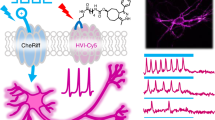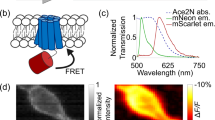Abstract
We used two new coral fluorescent proteins as fluorescence resonance energy transfer (FRET) donor and acceptor to develop a voltage sensor, named Mermaid, that displays ∼40% changes in emission ratio per 100 mV, allowing for direct visualization of electrical activities in cultured excitable cells. Notably, Mermaid has fast on-off kinetics at warm (∼33 °C) temperatures and can report voltage spikes comparable to action potentials.
This is a preview of subscription content, access via your institution
Access options
Subscribe to this journal
Receive 12 print issues and online access
$259.00 per year
only $21.58 per issue
Buy this article
- Purchase on Springer Link
- Instant access to full article PDF
Prices may be subject to local taxes which are calculated during checkout


Similar content being viewed by others
References
Tsien, R.Y. Annu. Rev. Biochem. 67, 509–544 (1998).
Miyawaki, A. Neuron 48, 189–199 (2005).
Nagai, T. et al. Proc. Natl. Acad. Sci. USA 101, 10554–10559 (2004).
Campbell, R.E. et al. Proc. Natl. Acad. Sci. USA 99, 7877–7882 (2002).
Karasawa, S. et al. Biochem. J. 381, 307–312 (2004).
Siegel, M.S. & Isacoff, E.Y. Neuron 4, 735–741 (1997).
Guerrero, G. et al. Biophys. J. 83, 3607–3618 (2002).
Sakai, R. et al. Eur. J. Neurosci. 12, 2314–2318 (2001).
Ataka, K. et al. Biophys. J. 82, 509–516 (2002).
Murata, Y. et al. Nature 435, 1239–1243 (2005).
Dimitrov, D. et al. PLoS One 5, e440 (2007).
Seoh, S.A. et al. Neuron 16, 1159–1167 (1996).
Kohout, S.C. et al. Nat. Struct. Mol. Biol. 15, 106–108 (2008).
McCobb, D.P. & Beam, K.G. Neuron 7, 119–127 (1991).
Bean, B.P. Nat. Rev. Neurosci. 8, 451–465 (2007).
Acknowledgements
We thank M. Higa and staff at Sesoko Marine Station of Ryuku University for their support during our excursions for sample collection. This work was partly supported by grants from Japan Ministry of Education, Culture, Sports, Science and Technology Grant-in-Aid for Scientific Research on priority areas, the Human Frontier Science Program and Special Postdoctoral Researcher Program of RIKEN.
Author information
Authors and Affiliations
Contributions
S.K. developed mKOκ. H.T. performed experiments to develop mUKG and Mermaid. H.T. and Y.O. designed experiments in regard to VSD. H.T. and A.M. designed experiments with regard to fluorescent proteins and FRET. H.T. and A.M. wrote the paper. A.M. supervised this project.
Corresponding author
Ethics declarations
Competing interests
S.K. is employed by Amalgaam. A.M. is a member of the scientific advisory board of Amalgaam. Amalgaam will sell mUKG and mKOκ
Supplementary information
Supplementary Text and Figures
Supplementary Figures 1–6, Supplementary Methods, Supplementary Table 1 (PDF 868 kb)
Rights and permissions
About this article
Cite this article
Tsutsui, H., Karasawa, S., Okamura, Y. et al. Improving membrane voltage measurements using FRET with new fluorescent proteins. Nat Methods 5, 683–685 (2008). https://doi.org/10.1038/nmeth.1235
Received:
Accepted:
Published:
Issue Date:
DOI: https://doi.org/10.1038/nmeth.1235
This article is cited by
-
Polarized focal adhesion kinase activity within a focal adhesion during cell migration
Nature Chemical Biology (2023)
-
Selection of red fluorescent protein for genetic labeling of mitochondria and intercellular transfer of viable mitochondria
Scientific Reports (2022)
-
Live-cell fluorescence spectral imaging as a data science challenge
Biophysical Reviews (2022)
-
Robust and flexible platform for directed evolution of yeast genetic switches
Nature Communications (2021)
-
Genomic and physiological analyses of the zebrafish atrioventricular canal reveal molecular building blocks of the secondary pacemaker region
Cellular and Molecular Life Sciences (2021)



